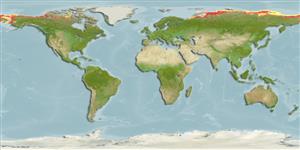分类 / Names
俗名 | 同种异名 | Catalog of Fishes(属, 种) | ITIS | CoL | WoRMS | Cloffa
Teleostei >
Salmoniformes (Salmons) >
Salmonidae (Salmonids) > Coregoninae
Etymology: Coregonus: Greek, kore = pupils of the eye + Greek, gonia = angle (Ref. 45335); sardinella: sardinella meaning small sardine (Ref. 1998).
More on author: Valenciennes.
Environment: milieu / climate zone / depth range / distribution range
生态学
海洋; 淡水; 半咸淡水; 溯河洄游 (Ref. 51243). 極; 78°N - 62°N, 45°E - 95°W
North America: Murchison River, Canada to Bristol Bay, Alaska; ascends Yukon River to British Columbia, and Mackenzie River to Fort Simpson (Ref. 5723). Asia: Bering Sea, Chukot land and Kolyma River to Kara River on the northern end of the Urals (Ref. 593). Lakes and lower course of large rivers of Arctic Ocean basin from Pechora drainage to eastern Siberia (Ref. 59043). Belongs to Coregonus artedi complex. Occasionally hybridizes with Coregonus nelsoni (Ref. 27547).
北美洲: 在加拿大到布里斯多海灣,阿拉斯加州的 Murchison 河。 亞洲: 到在烏拉河的北方末端上的喀拉海河的白令海, Chukot 土地與科力馬河河.(參考文獻 593) 這種是與 Coregonus albula 同種。 (參考文獻 7506) 屬於 Coregonus artedi 複合體。 偶然地與 Coregonus nelsoni 雜交。 (參考文獻 27547)
大小 / 重量 / 年龄
Maturity: Lm ? range ? - ? cm
Max length : 47.0 cm TL 雄鱼/尚未辨别雌雄; (Ref. 5723); common length : 23.0 cm TL 雄鱼/尚未辨别雌雄; (Ref. 1998); 最大体重: 555.00 g (Ref. 593); 最大年龄: 26 年 (Ref. 1998)
背棘 (总数) : 0; 背的软条 (总数) : 12 - 14; 臀棘: 0; 臀鳍软条: 10 - 13; 脊椎骨: 58 - 64. Body elongate, somewhat compressed laterally, greatest body depth at front of dorsal fin. Head about 19 - 24 % of total length; eyes large; snout length usually less than eye diameter; mouth moderate, terminal, lower jaw always protruding, maxillary at a distinct angle, extending posteriorly to below anterior half of the eye; a small cluster of teeth present on the tongue. Overall coloration silvery, usually brown to dark green on the back, becoming silvery on sides and below. The small non-anadromous form that remains in fresh water is without spotting on the back and only the pelvic fins have black pigment on the tips., the remaining fins are unpigmented. The larger, anadromous form has dark spots on the head, back, dorsal, and adipose fins, and sometimes, on the pectoral fins; all fins have usually dark pigment on the tips.
细长的身体, 略微扁长形的侧面地, 在背鳍的前面最大的体高。 头部大约 19- 24% 的全长; 眼大的; 吻的长度通常少于眼直径; 嘴中等的,末端的, 下颌总是伸出, 上颌骨以一个明显的角, 向后延伸到在前半部的之下眼; 齿的小群位于舌之上。 整体的颜色银色的, 通常褐色到深绿色的在背部上, 变成银色的侧边以下之上。 逗留在的小的非溯河洄游产卵的形式淡水是没有在背部上斑点与只有腹鳍在顶端上有黑色素。, 剩余的鳍是没有颜色。 比较大又溯河洄游产卵的形式在头部,背面上有深色的斑点, 背部的, 与脂肪的鳍, 与有时, 在胸鳍上; 所有的鳍通常有深色的在顶端上。
Adults occur in coastal waters, estuaries, large lakes and rivers (Ref. 5723). Lake-dwelling populations appear to be non-migratory, while those found in streams or brackish water move considerable distances to reach or leave spawning sites (Ref. 27547). Semi-anadromous populations forage in estuaries, lower courses of rivers, backwaters and lakes (Ref. 59043). Nerito-pelagic (Ref. 58426). Feed on planktonic crustaceans and insects (Ref. 1998); also plant material (Ref. 27547) and fishes (Ref. 58426). Do not usually feed during its spawning run (Ref. 28219, 28860, 28861). Migratory forms are observed to live longer than fresh water forms (Ref. 1998). Spawn in deep pools on sand and gravel (Ref. 59043). Flesh is said to be tasty (Ref. 1998).
出现于沿岸水域,河口,大的湖与河。 (参考文献 5723) 湖居的族群状似非回游性而那些发现于溪流了或者半淡咸水移动相当多的距离达到或者离开产卵区。 (参考文献 27547) 吃浮游性甲壳动物与昆虫;(参考文献 1998) 也植物.(参考文献 27547) 在它的产卵的溪流的时候通常不进食。 (参考文献 28219,28860,28861) 回游的造型被观察活的较长胜于淡水的造型。 (参考文献 1998) 肉据说好吃的.(参考文献 1998)
Spawning occurs at night, peaking between 8 pm and midnight. A female spawns almost vertically upward, with her ventral side upstream. She is joined by as many as five males who swim vertically and close to her. As the spawners approach the surface, eggs and milt are released. The fish break the surface, fall over backward, and swim back to the bottom of the pool (Ref. 27547).北美洲: 在加拿大到布里斯多海灣,阿拉斯加州的 Murchison 河。 亞洲: 到在烏拉河的北方末端上的喀拉海河的白令海, Chukot 土地與科力馬河河.(參考文獻 593) 這種是與 Coregonus albula 同種。 (參考文獻 7506) 屬於 Coregonus artedi 複合體。 偶然地與 Coregonus nelsoni 雜交。 (參考文獻 27547)
Page, L.M. and B.M. Burr, 1991. A field guide to freshwater fishes of North America north of Mexico. Houghton Mifflin Company, Boston. 432 p. (Ref. 5723)
人类利用
渔业: 商业性; 游钓鱼种: 是的
工具
特别资料
下载 XML
网络资源
Estimates based on models
Preferred temperature (Ref.
123201): -1.8 - 2.7, mean -0.8 °C (based on 1616 cells).
Phylogenetic diversity index (Ref.
82804): PD
50 = 0.5000 [Uniqueness, from 0.5 = low to 2.0 = high].
Bayesian length-weight: a=0.00437 (0.00373 - 0.00511), b=3.21 (3.17 - 3.25), in cm total length, based on LWR estimates for this species (Ref.
93245).
营养阶层 (Ref.
69278): 3.2 ±0.2 se; based on diet studies.
回复力 (Ref.
120179): 中等的, 族群倍增时间最少 1.4 - 4.4年 (K=0.40; tm=2-4; tmax=11; Fec=2,500).
Prior r = 0.51, 95% CL = 0.34 - 0.76, Based on 2 data-limited stock assessments.
Fishing Vulnerability (Ref.
59153): Moderate to high vulnerability (52 of 100).
Nutrients (Ref.
124155): Calcium = 20.4 [9.1, 37.8] mg/100g; Iron = 0.52 [0.25, 0.99] mg/100g; Protein = 18.1 [16.9, 19.3] %; Omega3 = 0.696 [0.272, 1.918] g/100g; Selenium = 11.1 [4.1, 30.5] μg/100g; VitaminA = 6.92 [1.15, 41.73] μg/100g; Zinc = 0.521 [0.395, 0.737] mg/100g (wet weight);
